“Been in America”: Interviews with German researchers in the USA and Canada
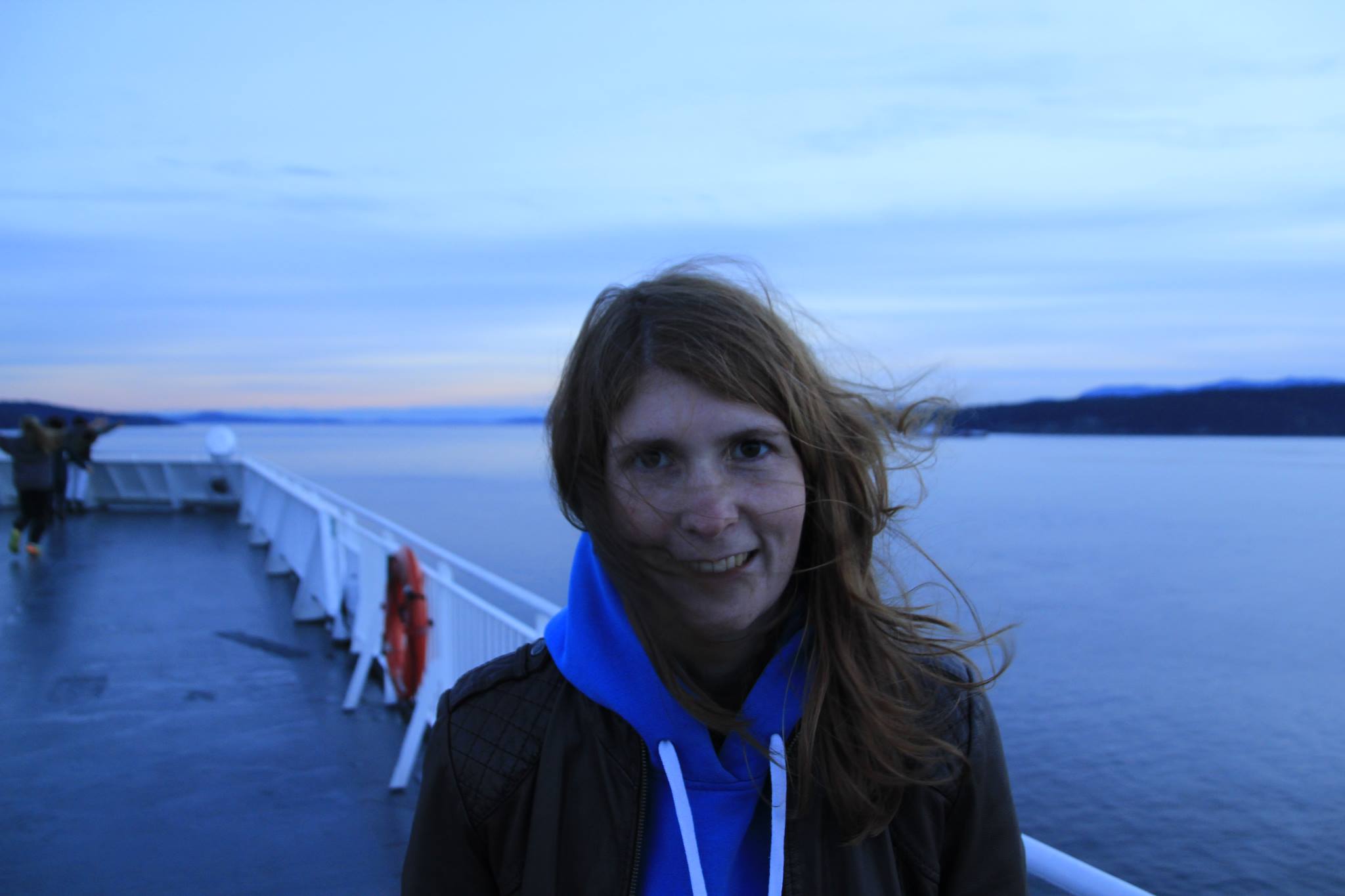
Jolande Fooken
© Privat
Through its research fellowship program, and since 2019 through the Walter Benjamin Program, the DFG supports junior scientists in their academic careers by funding an independent research project either abroad or in Germany. A large proportion of these fellowships are awarded in the USA and Canada, reflecting the belief still prevalent in many disciplines – and in the life sciences in particular – that for a career in research it is helpful to have “been in America.” In this series of talks, we aim to give you an impression of the range of DFG funding recipients. Let’s take a look at who is behind funding number FO 1347.
DFG: Ms. Fooken, thank you so much for taking the time to talk to the DFG Office North America. You’re joining us via video from Kingston in Ontario and it is 10:30 in the morning. How did you start your day, and what is your typical routine these days?
Jolande Fooken (JF): Allow me to reciprocate right away and offer my own sincere thanks – after all, without my DFG fellowship, a research stay in Canada would have been unthinkable for me and my family, and that takes me straight to the answer to your question. My husband and I have two children, aged five and two and a half, and we always draw straws in the morning as to who’s going to break it to the children that it’s time to get out of bed! Today I lost out, so it was my job to initiate the whole operation shortly before eight o’clock – getting up, having breakfast and getting ready. After this hour of the usual family chaos, we’re able to dedicate ourselves to our work as we know the children are in very good hands at the nursery or pre-school until 5 pm. My husband is a geologist and computer scientist and can essentially work from home. For me, the pandemic also had an impact since any kind of daily routine at the lab was impossible for a long time, so I was also working from home a lot. Things are rapidly returning to normal, however, so I’m glad to say I’m now increasingly spending my working day in the lab again.
DFG: Before you give us an insight into what you do in the lab, do tell us about your background and how you went from studying physics at RWTH Aachen University to doing research on hand-eye coordination in humans.
JF: That’s a bit of a lengthy story.
DFG: We have plenty of time!
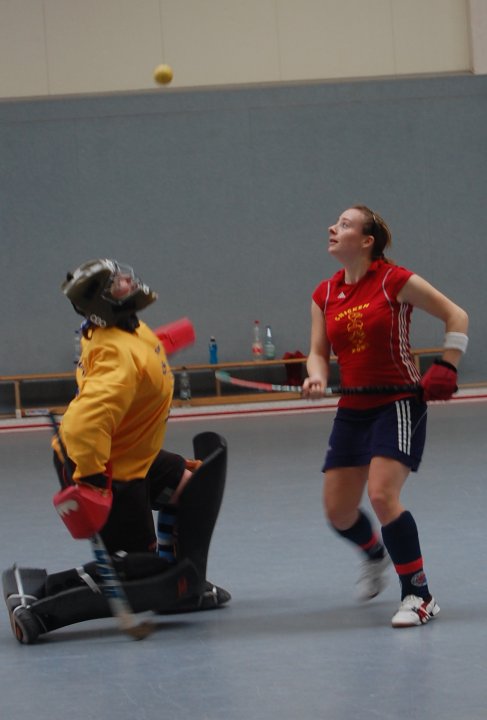
Playing hockey
© Privat
JF: During my last two years of high school I was at a school which specialized in classical humanities – that wasn’t the best fit at the time because I had more of an aptitude for math and science. In grade 11, an exchange year to Nova Scotia, Canada sparked my love of adventure, travel, and foreign cultures. So when I came back, I took English as a special subject in addition to math. This was probably just about tolerated at a secondary school where the focus was on Latin and Greek.
After graduating from secondary school, I spent six months in Kuala Lumpur working for the Malaysian Hockey Federation. I was a dedicated amateur hockey player for a long time, though I haven’t played since the pandemic started. Nowadays I only get to swing my hockey stick when I’m on my skates, chasing my husband or children across the ice.
Anyway, when I came back to Germany from Kuala Lumpur, it was the beginning of the summer semester and you could only enrol in a limited number of subjects. With barely two weeks to go after returning from Malaysia, I ended up enrolling in physics at RWTH Aachen University. Looking back, I wish there had been more opportunities for an organized gap year – a community service year or similar – that didn’t leave a gap the CV, and that reassured parents that their kids are standing on their own two feet.
DFG: What do your parents do for a living?
JF: My father is a psychoanalyst and my mother a psychologist.
DFG: So physics was the right choice for other reasons, too, right?
JF: Are you a psychoanalyst as well? You may be right – and children often seek fields of interest that are as far away from those of their parents as possible. That probably applies to physics in my case – and to my brother’s career choice: he went to Australia and did a doctorate in economics. But he now works in business psychology – and I didn’t become a physicist.
DFG: Why didn’t you?
JF: At the start of my studies I really enjoyed physics, but as soon as I started to specialize, I was much less sure of my passion for research topics than the majority of my fellow students. So for my bachelor’s thesis I studied a biomedical application of physical – in my case magnetic – processes that aimed to advance so called drug targeting, namely the accumulation of active substances in the body in exactly the places where you really want them and where they are more useful than if they were toxic. This works with nano-particles and magnetic manipulation, for example, and that was the subject of my bachelor’s thesis.
DFG: But your bachelor’s degree wasn’t the end of the story.
JF: No, I got passionate about the subject and immediately applied to RWTH to do a master’s in biomedical engineering. It was an excellent international program, taught entirely in English and – as I found out – very competitive, because at first I only made it onto the waiting list.
DFG: But you didn’t have to wait long, did you?
JF: No, I was able to continue studying at RWTH without a break – likewise on the subject of using magnetic effects to control pharmaceutical agents in the human body.
DFG: But it’s still not a straight path from there to neuroscience. Where did you change course along the way?
JF: It was when I took a semester off to stay with my brother in Australia that my mother drew my attention to the subject of eye movement – something she was interested in from a psychological perspective: the eyes are a window into the mind, so to speak. But then I discovered an interest in this topic from a neuroscientific perspective and I wrote to Miriam Spering at the University of British Columbia with an application for a doctoral researcher position. She is both a psychologist and a neuroscientist and was the best person for me to go to for my doctorate, “Investigating eye movements as indicators of visual and cognitive processing. And roughly speaking, that’s the subject that has preoccupied me ever since.
DFG: In your current research project, you’re looking into the linking of eye and hand movements when people manipulate objects. Hasn’t this already been the subject of exhaustive research?
JF: Yes and no. There are lots of studies on the coordination of eye and hand movements – but they don’t yet extend beyond simplified situations. I’m looking at it in situations where several tasks or actions have to be performed at the same time. This is where things get interesting, because the ongoing prioritization increases the complexity of the whole thing considerably.
DFG: For the non-expert, this sounds like the ability to multi-task – which some people are said to have and others not.
JF: Yes exactly, it’s about understanding multi-tasking better, especially in situations where we perform a motor and mental task at the same time when we eat a meal and listen to another person speaking at the same time, for example. It may sometimes be useful to be able to say you’re not so good at multi-tasking – which is why you didn’t realize you were supposed to do the washing up later – but essentially all of us can cope very well in situations, where there is competition for our attention. Another example: just think of all the pedestrians who manage to cross the road more or less successfully while using their mobile phones.
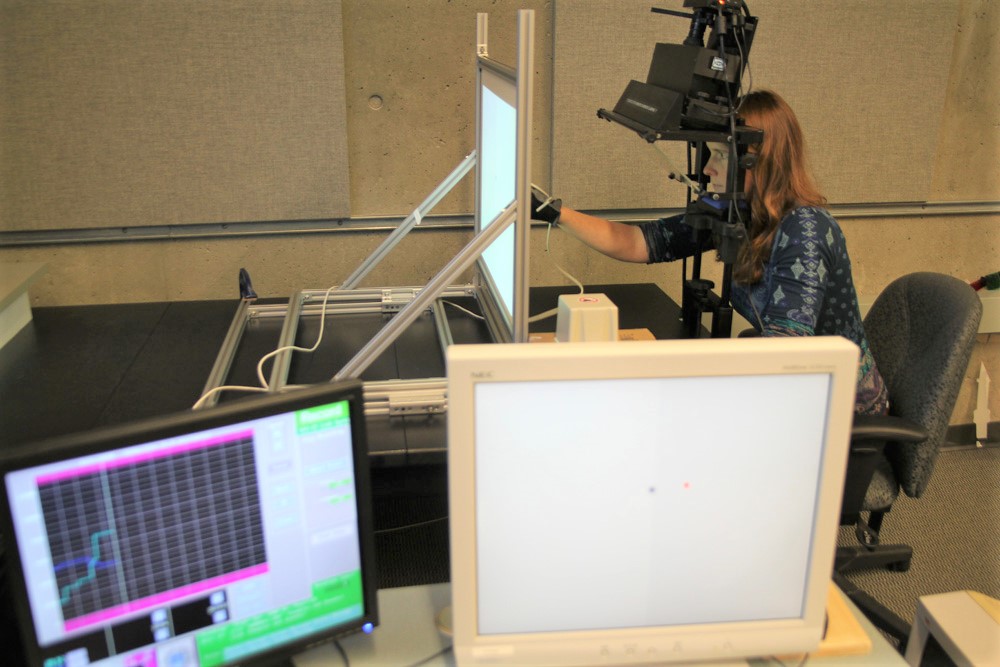
At the lab
© Privat
DFG: You generate data in the laboratory – what happens there exactly?
JF: For each experiment we test the eye and hand movements of about 10 to 20 participants who might be trying to place a marble into a tube, for example. At the same time, we show them a sequence of letters on a computer screen and our participants have to notice when a letter changes, for example an “m” changing to a “w.” The difficulty here is to allocate central vision to the motor and visual tasks at the same time. Because our eyes can only be directed to a single point in space at any given time, it is interesting to understand the coordination patterns between eye and hand movements. We then make our measurements, refine our hypotheses, develop new hypotheses and so on.
DFG: Where do you recruit your participants from and have you ever tested children – such as your own, for example?
JF: The vast majority of our participants are recruited on the university campus, which is why we have a bias in our data towards younger people. If you're aware of the bias, it’s not a methodological problem, however. I haven’t done any testing on children yet. That might be appealing, in particular because eye-hand coordination only works reliably enough for children to catch an object from a certain age onwards. Children can throw objects around (such as food) almost immediately after birth, but catching requires continuous tracking of a moving object and the appropriate hand-eye coordination. Our daughter is five now so that process is just starting, but maybe it would be interesting to look out for children who are able to catch a ball at the age of three – future handball champions.
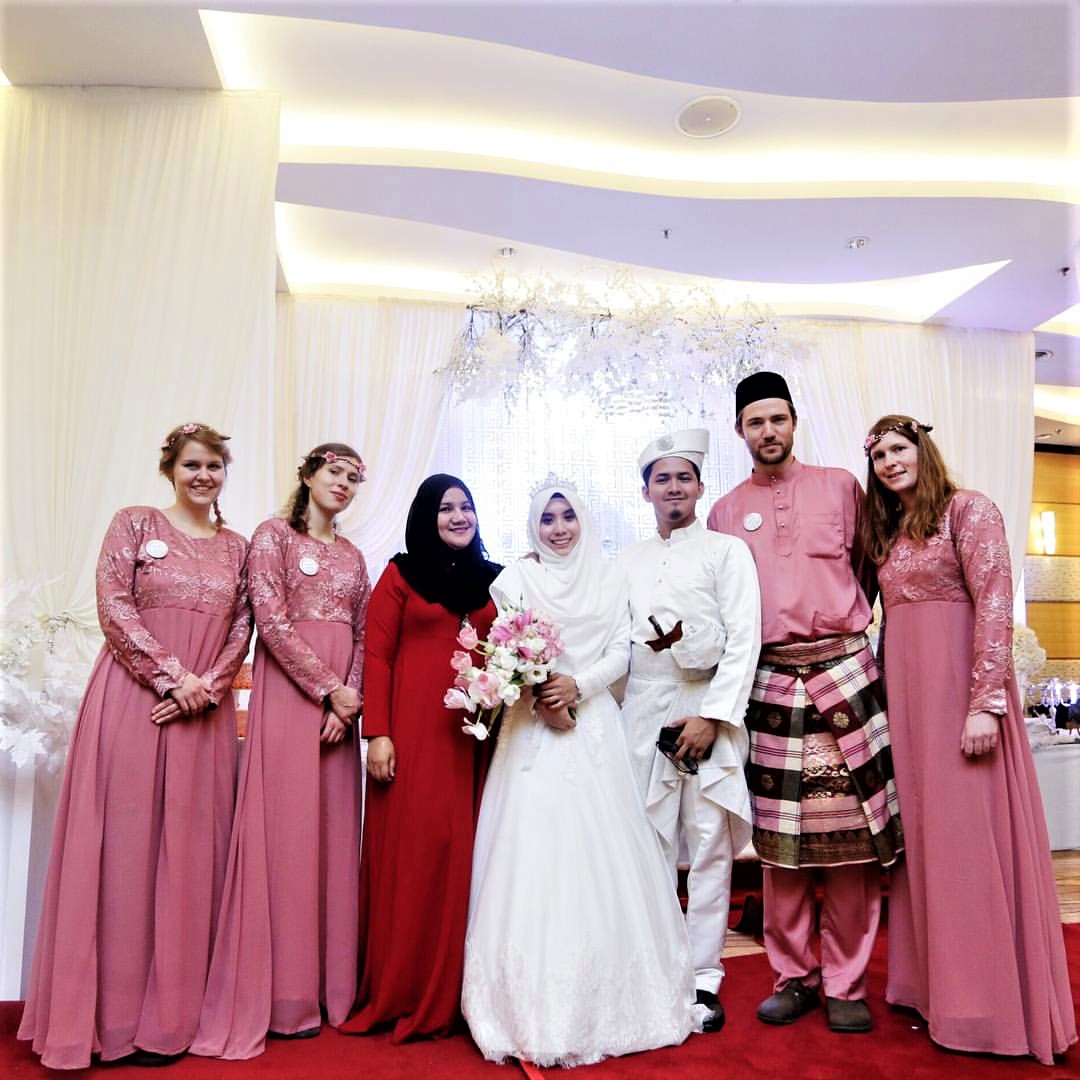
In Malaysia
© Privat
DFG: Aren’t your investigations of enormous interest to professional sports?
JF: Yes, especially when we look at situations where the participant has to interact with a moving object. Here it can be advantageous to anticipate the movement of the object, i.e. to move your eyes ahead of the stimulus. This is very important in a lot of ball sports as well as in contact sports. As such, our research results are of interest to many professional sports organizations, especially baseball, where a lot of scientific research has already been done. But there’s still quite a time lag between fundamental research, with its time-consuming analysis and publication mechanisms, and any potential application in sports. And anyway, we don’t yet understand enough to be able to speed things up. There are lots of interesting applications of our research outside of sports, too. One application is, for example, clinical research: many neurological disorders cause changes in eye movements and also eye-hand coordination. The ability to multi-task is lost, especially in the case of motor diseases such as Parkinson’s.
DFG: Can you tell from the measurements you take of people’s eyes whether your subject is young or old, male or female, good with their hands or clumsy?
JF: This is possible within certain limits, especially in the case of outliers from the statistical midfield, such as a professional baseball player. These people need far above-average hand-eye coordination to be good at their sport, though it’s virtually impossible to separate cause and effect: as in many other cases, extensive athletic training trains coordination, but at the same time, above average visual motor skills are a prerequisite for wanting to play the sport in the first place. Another characteristic of athletes is that they’re able to move their eyes very precisely, i.e. they can focus on a precise point very accurately. That’s something that gets lost in old age, when movements become a lot more variable, sometimes causing people to stumble. If I were to draw a distinction between a female and male response, my predictions probably wouldn’t be any better than the accuracy of chance – and I would question what the underlying hypothesis of such a difference would be in the first place.
DFG: You’re now no longer working in Miriam Spering’s group in Vancouver but have moved to Queens University in Kingston, Ontario, where you’re doing research as a member of Randy Flanagan's group. Don’t you miss the beautiful weather and landscapes of British Columbia? And what is your new working environment like?
JF: Vancouver as a city by the sea and the mountains is of course hard to beat in terms of scenery. But I don’t miss the six months of rain in winter – or the outrageous prices of the very desirable housing market. Nonetheless, “On-terrible” – as the Canadians say – is not nearly as terrible as people make out and it definitely has its own charms, especially for young families. The climatic change from deepest winter to tropical summer is truly incredible, and there are endless lakes of all sizes, colors and temperatures for swimming and fishing. So Randy Flanagan’s group is a great fit for me both academically and personally: the man himself is very involved in the individual projects in his group and always spilling over with ideas.
DFG: Where will your career go after the postdoc in Canada?
JF: I’d very much like to stay in academic research and qualify for a professorship by leading a junior research group. One possible avenue would be the DFG’s Emmy Noether Program, another would be the NRW Returnee Program. Where I finally end up applying will depend a bit on timing. Since my husband is fairly independent with his work, we’re very flexible with regard to where to go in Germany. The best groups in my field are currently in Gießen, Marburg, Bonn and Bielefeld – but plan A is not always the one that works out.
DFG: Would plan B or C perhaps be to go into industry?
JF: I wouldn’t want to rule it out completely, but in that case industry would probably be more like plan “I” for industry. I hope no one calls a lawyer when I say that it won’t be Facebook.
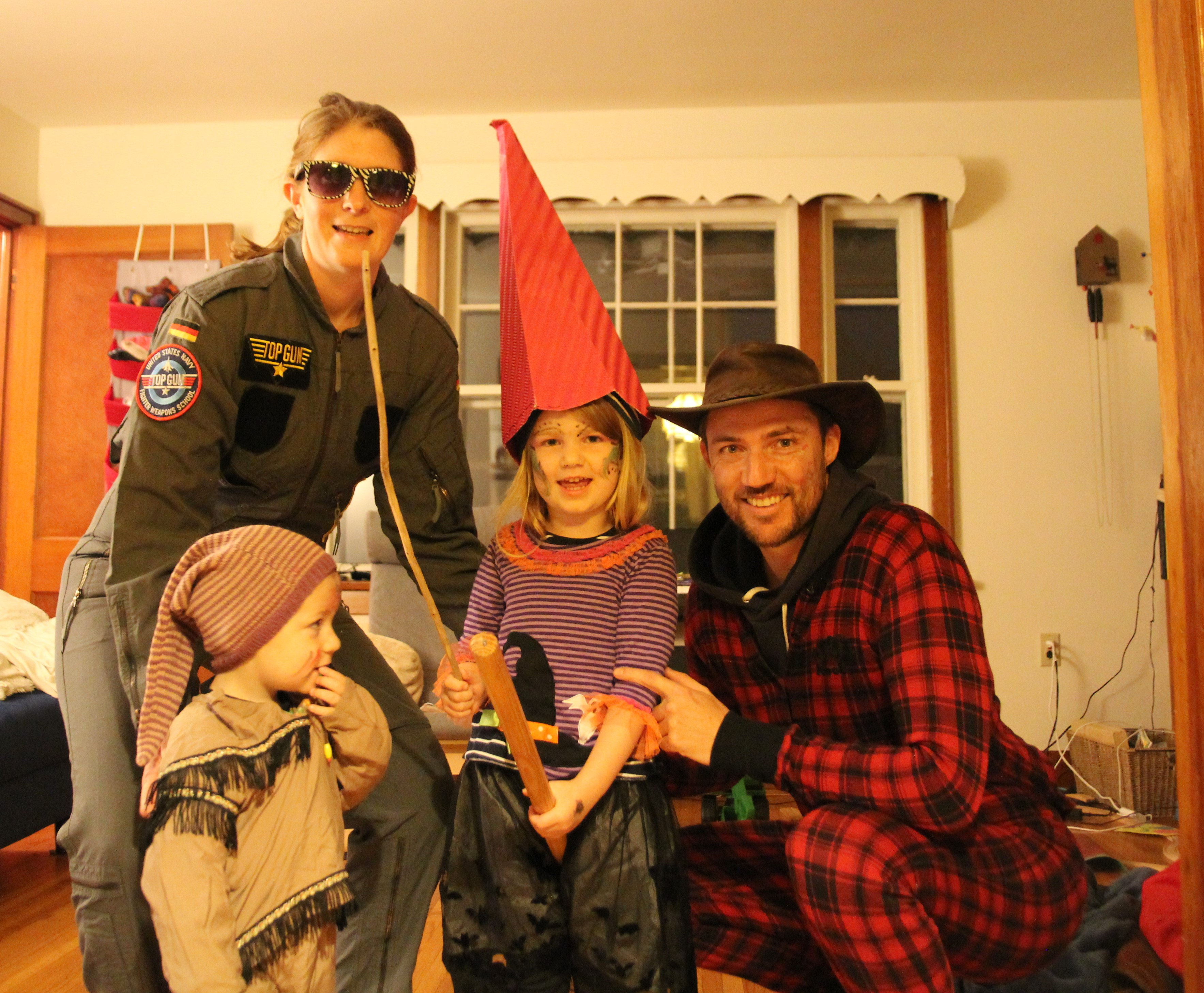
With the family
© Privat
DFG: Right – at the DFG we also believe that scholars should have principles. What do you particularly look forward to when you think about returning to Germany?
JF: Apart from the changes for my children, I look forward to being close to family and friends again – especially when FC Cologne play home matches. When Anthony Modeste scores another goal and makes that gesture of his indicating that he’s followed the ball very closely before he heads or shoots it into the net – that’s when I feel somehow confirmed in the results of my research, though in Modeste’s case it’s usually a matter of successful head-eye coordination.
DFG: FC Cologne currently look as if they might be looking at a place in the Champions League thanks to Modeste’s goals. Is Cologne going international in terms of football?
JF: Hopefully not: the last time they made it this far up the ladder, they were relegated to the second division the following season. In Germany, I’d like to see them in the Bundesliga, then they can happily settle down at the head of the table over the years to come.
DFG: Thank you very much for this analysis and for the interview. Those of us in Bonn and of course in North America will keep our fingers crossed that you continue to pursue a rewarding career – and that our Rhineland neighbors achieve sustained success in professional football.